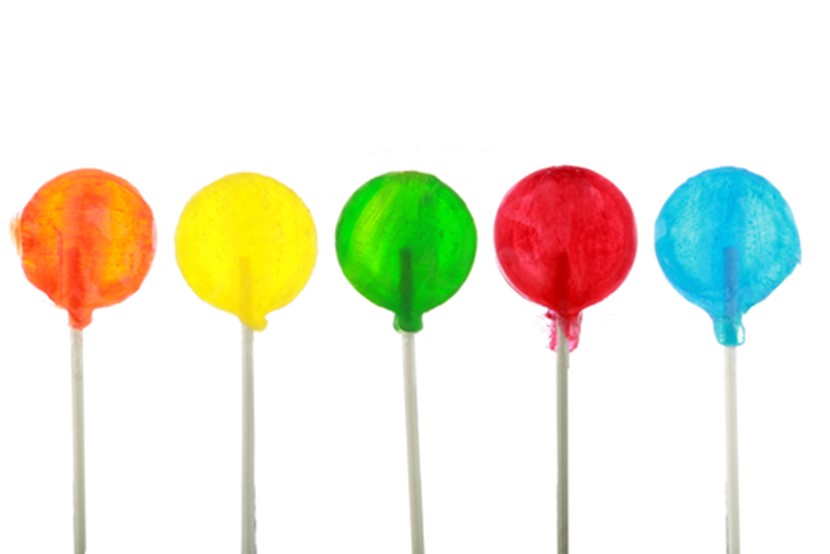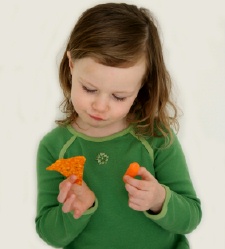Food additive habbit

Neon-orange peaches in fuschia-coloured strawberry jelly. Chartreuse banana-flavoured "dairy food". Green ketchup. Purple sausages. Blue fruit juice. Biscuits with shocking-pink icing and hundreds-and-thousands sprinkled over them. A quick scan of the supermarket shelves reveals a profusion of brightly coloured, visually enticing foods, all with one thing in common - their target audience. Children.
Feeding children a healthy, balanced meal isn't all that simple, especially when our lives are busy and high-stress. So we reach for the quick, okay-looking options - cracker-and-cheese-dip combos, prepackaged fruit bars, and jam sandwiches are fast ways to fill up a school lunch box or keep a hungry toddler occupied in their pram while running errands. And the food that's especially appealing to kids - with the fun packaging and colourful appearance -- doesn't seem to be too bad for them, as they contain healthy ingredients like fruit, nuts, or mixed grains. Besides, it's not like we're giving them lollies, right? I mean, come on - a fruit bar is a healthy snack, at least… isn't it?
It turns out that even seemingly healthy foods often contain additives, preservatives, and artificial colours. And these additives can have adverse effects on children's behaviour. In fact, a recent study published in the medical journal The Lancet has shown that artificial colour and food additives commonly found in those brightly coloured, visually appealing foods marketed specifically at littlies can increase hyperactivity in children.
When researchers gave 153 three-year-olds and 144 eight- and nine-year-olds either a drink containing the preservative sodium benzoate, along with one of two artificial food colour and additive mixes, or a placebo drink, they found a significant increase in hyperactivity levels among the children who received the drink with the additives.
If you've ever been to a children's birthday party and seen the kids rushing around on what parents commonly term a "sugar high", think again - that "sugar high" is more likely to be due to the additives and artificial colourings found in common birthday-party fodder like chips, lollies, and cookies.
Why are additives even in the food we eat? It's not terribly easy to find anything on the supermarket shelves that doesn't contain at least one additive of some kind. Here's a list of the most common types of additives, and why they're in our food.
- Preservatives are used to prolong the shelf life of foods, stopping them from going mouldy, rancid, or "off". Benzoates, like the sodium benzoate used in the study, are used in many drinks, sauces, and preserves like jam and chutney.
- Artificial colours are used in foods to make them look more appealing, to replace natural colour that is lost during pre-cooking and processing, and even sometimes to make foods look more "natural" (like those neon-orange peaches mentioned above).
- Nitrates and nitrites are used to prevent botulism, which is a highly toxic bacteria that causes food poisoning, from developing in meat and fish.
- Artificlal antioxidants keep oils and fats from going rancid, as well as prevent artificial flavourings and colourings from decomposing. Antioxidants do appear naturally in some foods, like good-quality vegetable oils.
- Artificial flavourings are used to "pump up" flavour in processed foods, to mask unpleasant chemical flavours, or to replace natural flavours, such as artificial sweeteners that are often found in "diet" or "lite" products. Flavour enhancers like monosodium glutamate (MSG) is one of the most widely used artificial flavourings, and one of the most controversial.
So what can parents do to avoid these potentially harmful ingredients? Well, unless you move your family to an isolated, remote farm and organically grow your own fruits, vegetables and grains, while raising your own animals for meat and milk, it is very hard to avoid food additives. Buying organic, additive-free food is very expensive, and your choices are somewhat limited, especially if you live in a small town. And reading all of the labels on the foods in the supermarket will drive you mad, not to mention take you hours (not a good idea with a cranky toddler in tow!).
Your best option is to work on reducing your intake of foods containing significant amounts of additives. This means choosing fresh foods whenever possible, rather than highly processed foods. Shop around the outside walls of the supermarket - where the fresh produce, fish, meat, and dairy items are located. Remember that you can easily freeze lots of fresh items if you're worried about them going "off" before you can eat them.
You don't have to go cold-turkey on quitting the food additive habit. It's quite intimidating to think of making your pantry and fridge additive-free all at once. But you can change your eating and buying habits slowly, one item at a time. Pick out one item in your cupboard and see what it contains. If it's full of artificial flavours, colours, and preservatives, think about replacing that item with one that's additive-free next time you do your grocery shopping. If you can't find an additive-free replacement, or you can find one but it's too expensive, then choose one with less additives than the item you're replacing. Fewer food additives is still a better option for your family.
If a food doesn't look natural, it probably contains additives. That blue juice didn't get its colour from Mother Nature (unless it's blueberry juice, that is…)! Skip the brightly coloured foods that you know are marketed specifically to children, and choose more natural choices. Even if you can eliminate just one artificial food colouring from their diet, you are making a difference to their health. And because foods that are marketed at children often contain huge amounts of artificial colours, children can consume a much larger proportion of artificial colours than adults.
Steer clear of artificial sweeteners, too. While it's tempting to choose "diet" options because they seem healthier, they're often chock-full of artificial sweeteners, flavourings, and colours. Use natural sweeteners like sugar, honey, or maple syrup instead - just use them in moderation.
If you have time, try your hand at making as many of your family's meals from scratch as possible. It probably sounds impossible, and it often is when you have children and are always on the run. But if you can replace one weekly meal of fast food or prepackaged food with fresh, prepared-from-scratch food, you will be improving your children's health. Slow cookers (crock pots) are one of the easiest ways to prepare a meal - put all of your ingredients in when the baby is down for its morning nap and the toddler is colouring at the table (or on the walls), turn it on, and leave it until dinnertime. Or make a big batch of pasta sauce from scratch using tinned tomatoes and diced carrots, broccoli, courgettes and capsicums, then freeze half for later and use the rest with pasta at dinnertime. Soup bases are also simple to make - fry up some diced onions, carrots, and celery in a little bit of olive oil, then freeze in one-cup batches for future use in noodle soups and stocks.
But most importantly of all, don't get stressed out if you've just realised that the breakfast you gave your toddler was full of additives that may be making him hyperactive. Take a deep breath, and be grateful he ate something, instead of smearing it in his hair, feeding it to the dog, and decorating the carpet with it (and even if he did do those things, be grateful for the bites of food that he DID eat). To break the food additive habit, you have to start somewhere, and take it one food item at a time.

